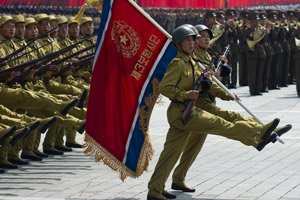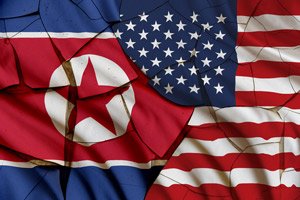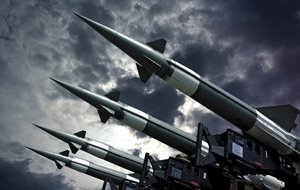Last week, we showed you one possible way our current standoff with North Korea might end.
To me, it’s been clear since the outset what the North Koreans’ own endgame was here. And it was clear that Pyongyang’s weapons program was developing faster than the “experts” realized – or faster than the Pentagon was willing to publicly admit.
Today, I’m going to show you six options the Trump administration has for bringing this to resolution.
None of them are great, and some are downright nightmarish.
There are, however, a couple of really great opportunities for savvy investors who follow this story and know the places to cash in.
Here they are…
Six Ways to Play… With Each, We Pay
Option No. 1: Lean on Beijing
From a geopolitical point of view, this is the best option for Washington. China shares an 880-mile border with North Korea. And there was once a lot of cross-border trade. Despite pressure from the United States, Beijing is reluctant to ramp up the sanctions it’s already put in place and really put the hammer to Pyongyang.
The reason: China fears both the economic fallout (from failed businesses and the loss of cheap labor) and the potential for a mass of North Korean refugees to surge into China (since 85% of North Korea’s trade is with China). Beijing didn’t respond well to the Trump administration’s most recent efforts to strong-arm China into playing the heavy with Pyongyang.
The takeaway: The whole “doing nothing themselves” bit is telling. Beijing won’t help without “incentives” – which brings us to the next option.
Option No. 2: A Total “Sellout” to Beijing
With its attempt to militarize the South China Sea, Beijing has roiled the waters with its Asian neighbors. But it can probably handle them one-on-one. That’s why it wants the United States out of the South China Sea.
Also, Beijing wants the U.S. Terminal High Altitude Area Defense (THAAD) ballistic missile defense system out of South Korea – worrying that the system’s powerful “X-band” radar will let the Pentagon “see” into mainland China. But China’s “THAAD tantrum” failed. Now, to get Beijing to really lean on Pyongyang, Trump will have to surrender both THAAD and the South China Sea – and perhaps Taiwan, too.
 The takeaway: For the United States, this would be a disaster. Like it or not, the nexus of global trade is moving from North America to Asia.
The takeaway: For the United States, this would be a disaster. Like it or not, the nexus of global trade is moving from North America to Asia.
Two-thirds of “real GDP” ($114 trillion) is due to China and Emerging Asia, while the former “Big Three” only account for 29% of what the world produces.
By abdicating its Asian foothold – both by retreating physically and “selling out” some of the smaller countries that want our involvement in the regional dispute, like Vietnam, the United States risks long-term economic irrelevance.
Option No. 3: Get Nasty with Beijing
As University of Texas Professor Austin Bay recently wrote, “Strategic patience with Chinese posturing will [eventually] end.” And Bay said that Beijing’s efforts to position itself as the “global adult” during the Trump era will ultimately be exposed as a sham because it’s backing the un-backable in North Korea.
And thanks to America’s newfound energy independence – something China doesn’t have – the United States has much more of an opportunity to damage that country than it does this one. What’s more, the United States and its allies could block needed access to raw materials, shut down China’s exports, and cut off that country’s big surge to buy U.S. farmland and real estate. This stops when Pyongyang denuclearizes.
The takeaway: This will definitely lead to a tit-for-tat trade war, which will hurt China more than the United States. But both countries will be damaged – and at a point in time when sky-high stock prices and a long-of-tooth U.S. expansion are at their most vulnerable.
Option No. 4: Do Nothing and Pretend It Goes Away
I’m being a bit facetious here, but just a little. This is essentially the strategy we’ve followed for decades. And it’s what has us at this juncture now. It means “accepting” a world where North Korea is a nuclear power – eventually with the ability to hit us with long-range missiles and submarine-launched ballistic missiles (SLBMs), a technology Pyongyang has been quickly developing and that we’ve been warning about here.
The takeaway: This strategy, and the failed policies that fueled it, has us in the current situation – facing an unpredictable leader who has nukes. Kim Jong Un has repeatedly stated his intent to hit the mainland United States with a nuclear-tipped ballistic missile.
And folks I’ve talked to that have been inside North Korea say that anti-American sentiment runs deep. Indeed, I’ve shared the story with Private Briefing subscribers about my talk with a former foreign correspondent for a major news network who showed slides of a propaganda poster that’s widely disseminated inside North Korea.
The poster shows a shredded American flag and an exploding U.S. Capitol dome being struck by additional North Korean missiles. It was a sobering presentation. Especially since this poster is apparently quite popular inside the Hermit Kingdom.
Option No. 5: Cut Off the Head of the Snake”
An assassination of Kim Jong Un is certainly an option being discussed in the darkest levels of the Pentagon.
The takeaway: There’s no guarantee this would work. Even the drone strikes on terrorists have caused blowback. And killing a head of state – no matter how despised – would be much trickier.
Option No. 6: Launch a Preemptive Strike
 We talked about this last week, when we detailed Israel’s 2007 air strike on a nuclear weapons reactor in Syria. But this strike would be much, much more complex.
We talked about this last week, when we detailed Israel’s 2007 air strike on a nuclear weapons reactor in Syria. But this strike would be much, much more complex.
First, North Korea’s reactor is fueled, meaning there’d be massive fallout.
Washington and Seoul have a “4D Strategy” (Detect, Defend, Disrupt, and Destroy) to hit Pyongyang’s missiles.
But that wouldn’t be easy either, because those weapons are spread about, some housed in deep caves or other underground facilities. You’d be looking at a joint strike of aircraft, ship- and sub-launched cruise missiles, “bunker-buster” bombs, smart bombs, and probably more than 2,000 conventional bombs – all hitting within a window of as little as 10 minutes.
Targets would include the missiles, launch sites, airfields, air defenses, radars, communication centers, and weapons storage sites. The United States and its allies would also have to be certain to have their ballistic missile interceptor systems ready in case of a counterstrike. And this initial attack would be followed by a number of additional clean-up strikes in the days and weeks that followed. You’re essentially talking about a restart of the Korean War.
The takeaway: There are risks in doing this and in not doing this. This kind of strike won’t improve America’s standing on the world stage. And the potential human and economic cost is staggering. North Korea has thousands of artillery pieces lined up to blast away at its southern neighbor’s capital, Seoul, a city of 26.5 million people – not to mention a global economic command center with a GDP of $1.5 trillion.
So what could be North Korea’s rationale for doing this in the first place? I’ll show you.
Why North Korea Is Pushing This to the Brink
During the Cold War, when the United States and Russia were the two main nuclear powers, “mutually assured destruction” (MAD) was a deterrent – and there was a military and geopolitical structure in place to provide some stability.
The sheer, overwhelming number of nuclear weapons split among NATO and the Warsaw Pact – tens and tens of thousands of warheads – in effect lent credibility to the MAD posture and provided some stability. It was what they once called “the balance of terror.”
 Not the case on the Korean Peninsula.
Not the case on the Korean Peninsula.
The concern here is that North Korea is a rogue country with, at most, a handful of warheads. It’s horrible to contemplate, but North Korea could “nuke” Seoul or eventually Guam or Anchorage.
There’s a wide opening for events to escalate here, rather than the disincentive that the MAD doctrine provided.
What’s worse, North Korea isn’t part of the geopolitical mainstream.
There isn’t a formal structure to engage in discussions or to talk in case there’s an emergency, like the “Red Phone” between the White House and the Kremlin.
In short, North Korea feels like it doesn’t have much of a voice.
This nuke program effectively gives it one. A big one. This means Kim likely won’t stop until he is stopped, and he probably remembers what happened after Libyan dictator Muammar Gaddafi gave up his nuclear program.
Pyongyang now fervently believes that having a workable nuclear weapon and a ballistic missile delivery system gives it a lot of muscle on the world stage.
Every time Kim threatens the United States, his stock goes up in anti-Western circles – a lot.
Kim likely wants to use this to extract major economic and military concessions. And to protect himself.
But here the risk of a misunderstanding also escalates. And that’s dangerous.
Also, North Korea is well known for its willingness to sell its weapons for cash – a willingness that’s earned it the moniker “Missiles ‘R Us.”
That’s one of the big concerns – that it would sell a nuke to a terrorist group whose only goal would be to use it to kill lots of people.
The question now, of course, is how far along is Pyongyang?
Tong Zhao, a Beijing-based fellow at the Carnegie-Tsinghua Center for Global Policy’s Nuclear Policy Program, recently told CNN that, after five tests, North Korea probably has the ability to build a nuke small enough to fit into a KN-14 “Hwasong 14” ICBM nose cone.
 But the fact is, Pyongyang is working on another type of “delivery system.” And this one should really scare you.
But the fact is, Pyongyang is working on another type of “delivery system.” And this one should really scare you.
What I mean is submarine-launched ballistic missiles.
This would put North Korea firmly in the nuclear “big leagues” with the United States, United Kingdom, France, Russia, and China, all of which operate and continuously deploy ballistic missile subs.
Big-leaguers can hide their “boomers,” as the U.S. Navy calls them, in the world’s oceans or up under the Arctic ice. The United States has developed ocean-based sensor networks to defend against this, and during the Cold War we used our nuclear-powered fast attack subs to “trail” Soviet ballistic missile submarines. Once you have sub-launched nukes, “range” no longer matters. You can sit just offshore and launch. That’s the allure of SLBMs.
And that’s why North Korea is aggressively pursuing SLBM weapons technology. Popping up off our coast reduces the “range” required – and effectively puts the entire United States in harm’s way.
Here’s where that leaves us: No matter which of the options Washington chooses, the fact is that the Pentagon has to create a “missile shield” to try and protect America.
That means we’re talking about missile interceptor systems.
And that means two companies will be clear beneficiaries.
The Best Missile Shield Plays on the Market
Right now, there are two missile interceptor systems that have been deployed.
 The first is the aforementioned THAAD, which was successfully tested again this week.
The first is the aforementioned THAAD, which was successfully tested again this week.
THAAD has been deployed in Guam, in South Korea, and in the mainland United States. It’s designed to take on intermediate-range missiles.
Then there’s a system known as the “Ground-Based Midcourse Defense System” (GMD) – a more sophisticated setup that targets intercontinental missiles. That missile interceptor, too, recently recorded a successful test.
Because of this, I’m recommending shares in two companies.
The first is Lockheed Martin Corp. (NYSE: LMT), the prime contractor on THAAD. As global tensions surge, and as the “Asian arms race” we’ve been detailing continues its advance, expect Lockheed to be a big winner because of the broad scope of its business.
One reason is THAAD. Back in June, the Pentagon’s Missile Defense Agency told Congress that it planned to deliver 52 more THAAD interceptors to the U.S. Army between October of this year and September of next year – bringing total deliveries since May 2011 to 210 systems, according to Reuters.
And as the North Korean threat escalates, demand could rise.
Lockheed is moving into new areas – like hypersonic weapons, namely the new SR-72 “Son of Blackbird” hypersonic spy plane.
The second big beneficiary will be Boeing Co. (NYSE: BA), a company whose shares have given us a total return of 260% since we first recommended it back in September 2011. Two-thirds of Boeing’s business is commercial jets – which will see decent demand over the next 20 years.
But North Korea’s nuclear push serves as an additional “trigger” for Boeing, which is the prime contractor on the GMD interceptor program.
GMD is a “home-based” defense, meaning the missile interceptor batteries are here, on U.S. soil: One “battery” operates from Alaska’s Fort Greely and the other from California’s Vandenberg Air Force Base.
The GMD system aims to destroy the warhead during its midcourse, unpowered phase – not by blasting it, but rather with a “kinetic-kill weapon.” In short, GMD “kills” the warhead by smashing into it.
Like Lockheed, Boeing is also positioning itself as a technology leader in the “hypersonic arms race” – a sprint by China, Russia, and the United States to develop a new class of nuclear-tipped weapons known as “hypersonic glide vehicles,” or HGVs.
Boeing built and performed test flights of its X-51 WaveRider unmanned hypersonic aircraft (with an Aerojet engine) back in May 2013, reaching speeds of Mach 5 during a flight of 210 seconds – the longest-duration hypersonic flight on record at the time.
That makes Boeing a technology leader; the “know-how” is slated for use in the High-Speed Strike Weapon (HSSW), which the Pentagon wants to see enter service in the middle 2020s.
U.S. Secretary of State Rex Tillerson has said that Washington wants “to bring Kim Jong Un to his senses, not his knees” – and insists that a “regime change” is not America’s ultimate goal.
We’ll keep watching this for you.
— William Patalon III
[ad#mmpress]
Source: Money Morning

